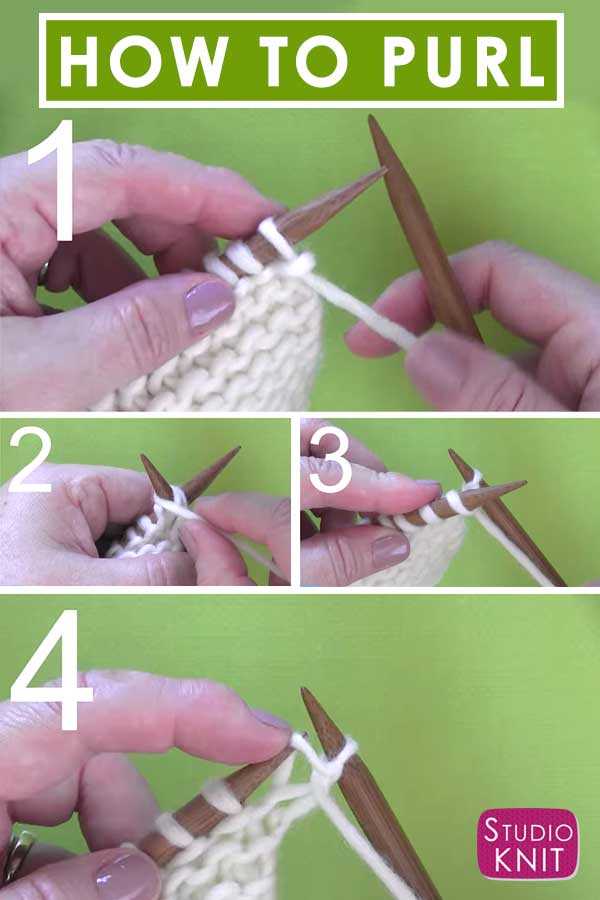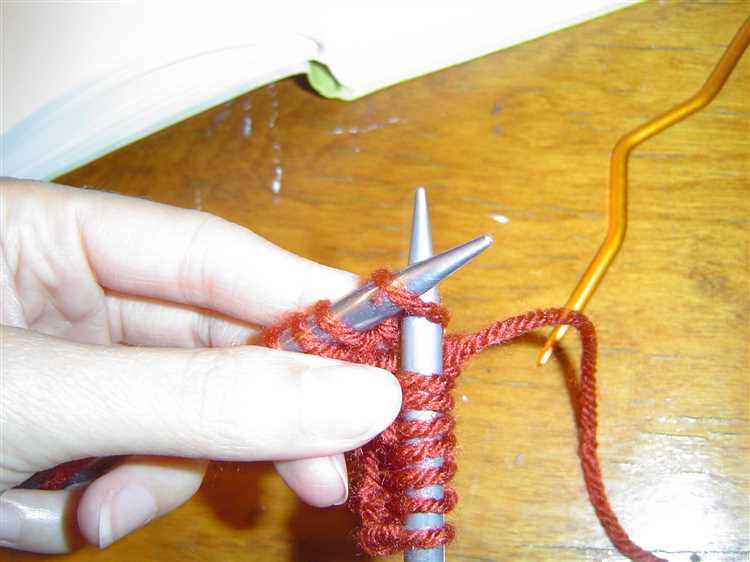Knitting is a popular craft that allows you to create beautiful and functional items using just a pair of needles and some yarn. If you’re just starting out, learning to purl knit is an essential skill to have in your repertoire. While knitting involves creating stitches, purling is the process of working those stitches in the opposite direction, creating a textured and versatile fabric.
In this step-by-step guide, we’ll walk you through the process of purl knitting, starting with the basics and gradually building up your skills. Whether you’ve never picked up a pair of knitting needles before or have some experience with knitting, this guide will help you master the purl stitch and take your knitting to the next level.
We’ll begin by explaining the anatomy of a purl stitch and the tools you’ll need. Then, we’ll guide you through the process of casting on, which is the foundation of any knitting project. Once you have your stitches on the needle, we’ll show you how to hold the yarn and work the purl stitch step-by-step. We’ll also cover common mistakes to avoid and offer troubleshooting tips along the way.
By the end of this guide, you’ll be able to confidently purl knit and tackle a wide range of knitting projects. Whether you’re interested in knitting sweaters, scarves, hats, or blankets, knowing how to purl will open up a world of possibilities for your knitting creations. So grab your needles, choose a ball of yarn, and let’s get started on your purl knitting journey!
What is Purl Knit?
Purl knitting is a technique used in knitting to create a specific type of stitch. It is one of the two main stitches used in knitting, with the other being the knit stitch. Purl stitches have a bumpier texture compared to knit stitches, and they are often used to create different patterns and textures in knitted projects.
To purl knit, the yarn is held in front of the work instead of behind it, and the needle is inserted into the stitch from right to left. The working yarn is then brought over the top of the right needle and pulled through the stitch, creating a new loop on the right needle.
Purl knitting is commonly used in combination with knit stitches to create various patterns, such as ribbing, cables, and lace. By alternating knit and purl stitches, intricate designs can be achieved.
When following a knitting pattern, purl stitches are usually indicated by the letter “p” or the word “purl.” For example, a knitting pattern might instruct you to “knit 2, purl 2” in order to create a rib stitch pattern.
Overall, purl knitting is an essential technique for knitters to learn, as it opens up a wide range of possibilities for creating unique and beautiful knitted items.
Tools and Materials for Purl Knitting
Before you begin your purl knitting project, you will need to gather a few essential tools and materials. Here is a list of everything you will need:
- Knitting Needles: Choose a pair of knitting needles that are appropriate for the yarn you will be using. Typically, a medium-sized pair of needles with a length of 10-14 inches is suitable for most purl knitting projects.
- Yarn: Select a yarn that is suitable for your purl knitting project. The weight of the yarn will depend on the finished look and feel you desire for your project. Lighter-weight yarns are often used for delicate items, while heavier yarns are great for cozy winter accessories.
- Tapestry Needle: A tapestry needle is essential for weaving in loose ends and finishing your purl knitting project.
- Scissors: Make sure to have a pair of scissors handy for cutting yarn and trimming any excess.
- Stitch Markers: Stitch markers can be helpful for marking specific stitches or sections in your purl knitting pattern.
Optional but recommended tools include:
- Row Counter: A row counter can help you keep track of the number of rows completed in your purl knitting project, especially for larger or more complex patterns.
- Measuring Tape: Having a measuring tape on hand can be helpful for checking the gauge of your purl knitting project and ensuring accurate sizing.
- Knitting Bag or Basket: A knitting bag or basket is useful for keeping all your purl knitting tools and materials organized and easily accessible.
- Knitting Pattern: If you are following a specific purl knitting pattern, make sure to have a printout or digital copy of the pattern handy.
Having the right tools and materials for purl knitting will make the process much more enjoyable and help you achieve beautiful results in your projects!
Step 1: Casting On
Before you can start purl knitting, you’ll need to cast on stitches onto your knitting needle. Casting on is the process of creating the foundation row of stitches that you’ll work with throughout your project.
Here’s how to cast on:
- Start with a slipknot. To create a slipknot, make a loop with the yarn, passing the working end of the yarn through the loop. Pull the loop tight, but not too tight, as you’ll need to insert your needle into it.
- Hold the slipknot in your non-dominant hand, with the working end of the yarn between your thumb and index finger. Insert the knitting needle into the slipknot from left to right, and tighten the loop by pulling the working end of the yarn.
- Wrap the yarn around your left hand. Hold the yarn between your thumb and index finger, allowing it to pass over your palm and under your pinky finger. This creates tension in the yarn, which is necessary for consistent stitch size.
- Using your right hand, insert the needle into the loop on your thumb. Bring the yarn over the needle from back to front, creating a new loop.
- Gently pull the new loop through the old loop, and slip it onto the knitting needle. Repeat this process until you have the desired number of stitches on your needle.
Remember to keep your stitches loose but even. You don’t want them to be too tight, as it will be difficult to work with, but you also don’t want them to be too loose, as it may result in uneven knitting.
 |
Tip: If you’re having trouble with casting on, you can watch video tutorials online, or ask a fellow knitter for help. |
Once you’ve successfully cast on your stitches, you’re ready to move on to the next step: the purl stitch.
Step 2: Purl Stitch Basics
Once you have mastered the knit stitch, it’s time to learn the purl stitch. The purl stitch creates a different texture on your knitted fabric and is often used in combination with the knit stitch to create various patterns and designs.
To do the purl stitch, follow these steps:
- Hold the knitting needles with the knitted fabric in your left hand and the working yarn in your right hand.
- Insert the right-hand needle from right to left into the next stitch on the left-hand needle.
- Wrap the working yarn counterclockwise around the right-hand needle.
- Bring the tip of the right-hand needle with the wrapped yarn through the stitch, from left to right.
- Slip the stitch off the left-hand needle.
- Now, you have completed one purl stitch.
- Repeat these steps for each stitch on the left-hand needle until you have purled all the stitches.
Remember to keep a consistent tension on the working yarn and the stitches to create an even and neat purl stitch. It may take some practice to get the tension right, so don’t get discouraged if your first purl stitches don’t look perfect.
Once you feel comfortable with the purl stitch, you can start practicing different combinations of knit and purl stitches to create interesting patterns and textures in your knitting projects.
Now that you have learned the basics of the purl stitch, you are ready to move on to more advanced techniques and patterns. Stay tuned for the next steps in your knitting journey!
Step 3: Purl Knitting Techniques
Once you have mastered the basic knit stitch, it’s time to learn the purl stitch. Purl knitting is the opposite of knit knitting, and it creates a different texture on your fabric. Here are the different techniques you need to know for purl knitting:
Purl Stitch
The purl stitch is essentially the reverse of the knit stitch. Instead of inserting your right needle into the front of the loop, you will insert it from right to left into the back of the loop. Then, wrap the yarn counter-clockwise around the right needle, and pull it through the loop to create a new stitch.
Purling Stitches in a Row
When purling multiple stitches in a row, follow these steps for each stitch:
- Insert the right needle from right to left into the back of the loop.
- Wrap the yarn counter-clockwise around the right needle.
- Pull the right needle through the loop, creating a new stitch.
Purling in Pattern
Purling in pattern means following a specific sequence of knit and purl stitches to create a desired texture or design. Common patterns include ribbing, seed stitch, and moss stitch. To purl in pattern, simply alternate between the purl stitch and the knit stitch as instructed by the pattern.
Purling with Multiple Yarns
If you are working on a project that requires multiple yarns, such as colorwork or striping, you can purl with multiple yarns. Simply hold the yarn not in use in your left hand and bring it under the working yarn as you purl the stitch. When you need to switch colors, drop the current yarn and pick up the new yarn to continue purling.
Combining Knit and Purl Stitches
Knitting and purling stitches can be combined to create a variety of patterns. For example, by alternating between one row of knit stitches and one row of purl stitches, you can create the stockinette stitch. Experiment with different combinations of knit and purl stitches to create unique textures and designs.
Now that you know the basics of purl knitting, you can start exploring more advanced techniques and patterns. Happy purling!
Common Mistakes to Avoid in Purl Knitting
Purl knitting is a popular technique in knitting that creates a textured stitch pattern. While purl knitting may seem straightforward, beginners can make some common mistakes that can affect the final outcome of their project. Here are some of the most common mistakes to avoid when purl knitting:
-
Twisted or Loose Stitches: One of the most common mistakes in purl knitting is creating twisted or loose stitches. Twisted stitches can affect the appearance and integrity of the final fabric, while loose stitches may result in uneven tension. It’s important to ensure that the stitches sit evenly on the needle and are not twisted.
-
Inconsistent Tension: Maintaining consistent tension is vital in purl knitting. Inconsistent tension can lead to uneven stitches, creating an unattractive finished piece. Practice keeping a consistent tension by being mindful of how tightly you wrap the yarn around the needle.
-
Skipping Yarn Overs: When purl knitting, it’s essential to pay attention to yarn overs. A yarn over is created by bringing the yarn to the front of the work between two stitches. Skipping yarn overs can result in mistakes in the stitch pattern or affect the stitch count in lace knitting.
-
Purling the Wrong Stitch: Another common mistake in purl knitting is accidentally working the wrong stitch. This can happen when you miscount your stitches or lose track of your pattern. Double-checking your work before moving on to the next row can help to avoid this mistake.
-
Working Too Tightly: Working purl stitches too tightly can make the fabric tighter and less flexible. This can be especially noticeable when transitioning between knit and purl stitches. Practice finding a comfortable tension and avoid pulling the yarn too tightly when creating your purl stitches.
Avoiding these common mistakes in purl knitting will help you achieve neat and professional-looking results. Remember to practice, take your time, and pay attention to your work to improve your purl knitting skills.
Step 4: Increasing and Decreasing Stitches
Once you have become comfortable with basic purl knitting, you can move on to increasing and decreasing stitches. These techniques are essential for shaping your knitting projects.
Increasing Stitches:
- Make One Purl (M1P): To increase a stitch using the purl method, follow these steps:
- Insert the right-hand needle from back to front into the horizontal strand between the stitch just worked and the next stitch on the left-hand needle.
- Purl into the front of the strand.
- Transfer the new stitch onto the left-hand needle.
Decreasing Stitches:
- Purl Two Together (P2tog): To decrease a stitch by purling two stitches together, follow these steps:
- Insert the right-hand needle purlwise into the next two stitches on the left-hand needle.
- Purl the two stitches together as one.
- Purl Three Together (P3tog): To decrease a stitch by purling three stitches together, follow these steps:
- Insert the right-hand needle purlwise into the next three stitches on the left-hand needle.
- Purl the three stitches together as one.
By mastering increasing and decreasing stitches in purl knitting, you can create various patterns and shapes in your knitting projects. Practice these techniques to improve your knitting skills and take your projects to the next level!
Step 5: Binding Off and Finishing
Once you have completed your project and are ready to finish it off, you will need to bind off. Binding off is the process of creating an edge that will not unravel.
To bind off, follow these steps:
- Knit the first two stitches.
- Insert the left needle into the first stitch on the right needle.
- Lift the first stitch over the second stitch and off the right needle, leaving one stitch on the right needle.
- Knit one stitch.
- Repeat steps 2-4 until all stitches have been bound off.
- Cut the yarn, leaving a tail that is long enough to weave in at the end.
Now that you have bound off all the stitches, it’s time to finish your project. To do this, weave in any loose ends using a tapestry needle. Thread the needle with the yarn tail, and then insert the needle into the back of the work, following the path of the stitches. Continue weaving the yarn in and out of the stitches for a few inches to secure it.
After weaving in the ends, you can block your project if desired. Blocking involves shaping and smoothing the knitted fabric to give it a more finished look. To block your project, soak it in water, gently squeeze out the excess water, and then reshape it to the desired dimensions. Allow it to dry completely before removing the pins or weights used to hold it in place.
With the binding off and finishing complete, your knitting project is now ready to be enjoyed or gifted to someone special. Congratulate yourself on a job well done, and consider trying out new knitting stitches, patterns, and techniques to continue building your knitting skills.
FAQ:
What is purl knitting?
Purl knitting is a basic stitch in knitting that creates a raised rib pattern. It involves bringing the working yarn in front of the knitting needle, inserting the needle into the stitch from right to left, and wrapping the yarn counterclockwise around the needle before pulling it through the stitch.
What materials do I need to purl knit?
To purl knit, you will need knitting needles, a ball of yarn, and a pair of scissors. It’s also helpful to have a stitch marker and a tapestry needle for finishing touches.
Can I purl knit with circular needles?
Yes, you can purl knit using circular needles. Circular needles are a versatile option for both flat and circular knitting projects. To purl knit with circular needles, simply follow the same steps as you would with straight needles.
Are there any common mistakes beginners make when learning how to purl knit?
Yes, beginners often make common mistakes when first learning how to purl knit. Some common mistakes include knitting instead of purling, twisting the stitches, or dropping stitches. It’s important to take your time and practice consistently to avoid these mistakes.
What are some tips for improving my purl knitting?
To improve your purl knitting, try the following tips: hold your yarn consistently, maintain even tension, use the right needle size for your yarn, and practice regularly. You may also find it helpful to watch video tutorials or take a knitting class to learn new techniques and troubleshoot any issues.
Can I create different patterns using purl knitting?
Yes, you can create a variety of patterns using purl knitting. By combining knit stitches and purl stitches in different patterns and arrangements, you can create textured designs, ribbing, cables, and more. Experiment with different stitch combinations and patterns to create unique and beautiful knitted projects.


